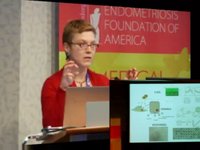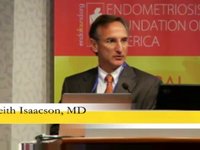Linda Griffith, PhD:
Thanks for this wonderful conference today and the invitation to share with you some of the progress we have made in the past year. We really did just start about a year and a half ago in the lab, and as Keith mentioned I came from a very different background than women’s reproductive health.
Before I start of my part of the talk I want to reorient to some of the language a little bit as we have worked together over the past couple of years there has been a lot of learning in language. For example, when Keith is in a research meeting with us and calls endometriosis a benign disease we bop him over the head with a book and say non-malignant, but not benign. Similarly here in our engineering frame work we view the cues as the things outside the cell, these little dots here that will impinge on cell surface receptors, cytokine receptors, and growth factor receptors integrins for an example. So these might be things like IL-1 and so one. So those we consider the cues that come and stimulate the cell. The signals are, in our language, the things that get initiated inside the cell that transmit what those cues mean to the cell. So they process it through a bunch of signals much like the transistors and op-amps and things inside a radio transmits cues from the outside into something that processes information that yields a response. The response is migration proliferation and other macroscopic things.
I came into this with the view that engineering cell biology by trying to put together these frame works, we can observe phenomena and individual components of the system but what we need now to bring in is engineers who can think about how to put these things together. As Keith mentioned, when I started I worked in the area of tissue engineering, this is one of the experiments I did as an assistant professor with some clinicians from Children’s Hospital, trying to grow cartilage in the shape of a human ear and there it was a very simple process, you combine cells with the scaffold, but it turned out to be idiosyncratic for cartilage. You need to really think hard about how you manipulate these cues in a meaningful way to get the responses you want.
One thing when I started working with Keith on endometriosis at MIT, MIT actually did have a lot of interest in women’s health. This list of people you may have guessed from the little pink ribbon is a partial list of people I know at MIT who work on breast cancer. Breast cancer is a very acceptable thing for men to work on and discuss in a scientific setting. You can see all over campus and this is only a partial list, there is a whole scientific language for breast cancer, and men do not get embarrassed at all talking about it standing up at MIT faculty meetings. But, what I found a couple of years ago, it is very difficult to talk about things that are not either breast cancer or having a baby in a professional setting like MIT. Part of the mission of the Center was in the context of an engineering school, can we start to develop a scientific language that a lot of people are comfortable with that my colleagues are knowledgeable about and comfortable with. Over the past two years we have recruited a lot of the people, everyone with a star now works on some facet of endometriosis stimulated by getting samples from our lab.
Let me take you through one example of how we are thinking about cues, and how understanding not just one cue, it is IL-17, it is TNF alpha, and we can block that or manipulate that and suddenly we will have a cure. If you go on clinicaltrials.gov or actually in the literature you can find a lot of very promising ways that people have thought about intervening in one particular cytokine, try it in the clinic and it does not work. What we want to understand is there is a network of these cues and they work together and go up and down in ways that can, when you look at them in aggregate, influence endometriosis. So, as has been discussed earlier, we have immune and endocrine inter-reactions that facilitate the formation of lesions. We still do not understand the etiology but there are certainly hallmarks, such as progesterone resistance that we see, and again, individual components of the inflammatory process, such as an MP3 that are hallmarks of these lesions and then of the eutopic endometrium. When we looked at this picture we see there is a lot of murkiness still in how the local immune cell recruitment facilitates progression of this disease and accompanying progesterone resistance. We thought perhaps we could learn more – there are all different kinds of immune reactions, there is not one simple inflammatory response there are subtle differences between the kinds of inflammatory responses you might see in one tissue versus another. What we set out to do was say can we look for a vast set of signatures of inflammatory responses, not just measure a few cytokines 2, 3, 5 but actually there are methods now to measure multiple cytokines, so 50 at once. If we look at 50 of the key cytokines involved in these inflammatory reactions will they reveal facets of how this immune response is progressing, and yield insights into what is happening in women with the disease and without the disease? There are different ways we can analyze these mathematically.
So here we start and I am going to go through a little of the science and give you a big picture analogy for this. We get Keith’s patients and we analyze the peritoneal fluids, so we are focusing on the peritoneal fluid and we have this assay in the lab that is based on immuno-Bs and it lets us measure 50 of these cytokines with a fair degree of precision as I will show you. When we started out we looked in the literature to see all of the reports that have investigated cytokines going up and down in the peritoneal cavity looking for such insights previously. This is a summary, it is not listing all the references, but this is a summary of the published studies. There are 18 so you can see here where there has been ones that are consensus that they are decrease consensus in the literature that they are increased and then either conflicting reports or they do not change at all. These are all the studies that have been done. In our study we are going to measure 50 including some that have been previously investigated. All these in purple are ones that we are going to measure that have previously been investigated but also we have a lot novel targets in the particular cytokine assay that we are using. This is an overlap between what has been previously published and these 21 are the new ones we are going to look at here, simply because now we have all these validated antibodies available to us. This is the patient population. We are still in progress so this is unpublished, it is a work in progress and I am telling a story today to give you a sense of the kind of things we can learn. So patients with minimal or moderate to severe or patients who have been treated –the first thing we do is look across all these patients and look at the abundance of these cytokines and aggregate and select set of patient’s sample simply to calibrate whether we can measure these. This list, and you do not need to look at the individual scores, this has the patient disease state, this lists all the cytokines the average measurements across disease states and showing the variants. This is just breaking it down into the heat map for the individual, all the patients that we have studied. Again, you do not need to look at this because we will process it.
We take all of that data for individual cytokines, and we can ask in individual ways are they different, are things going up and down between patients and disease? These are across our disease states and this is just one of the cytokines, IL-6, you can see that there is lots of different statistical ways this particular cytokine comes out as being elevated in severe disease across all the statistical methods. We can do that with this entire set of the ones that show up, and it was not quite 50 but almost all 50 showed up as being detectable in all our samples, all but five. So we find in our studies, consensus with what people previously found of things that go and down. Again, the details on this, which ones, are not important for this talk today. But we also found several novel targets, which may be important potential drug targets.
Now, we have all this, things are going up and down in significant ways but how do they work together in order to cause disease? There are a lot of cytokines and it turns out a lot of them can have somewhat redundant functions. It turns out that there is a method of mathematical analysis where you can go in and say. “Are there particular linear combinations of cytokines that add up to be more important”? There may be, for example IL-6 and IL-8 may be serving similar functions. If you look at the sum of them ten may be a sum that means that you have significant disease but one patient may have an IL-6 score of eight and an IL-8 score of two and another patient may have the reverse. How do you make sense? You want to know what that sum is. It is sort of like when you go on a diet if you cut out Oreo cookies but then you the substitute peanut M&Ms and you have the same calories you still end up not losing weight, and it is the same thing with the cytokines.
We go through and do a regression and what we can do is pull out then linear combinations of cytokines that change together. We take all of these data and anything that shows up high here is very significant as being predictive of disease. So this lets us separate out into groups the combinations of things that say we are going to be predictive of disease.
A second thing we do is which cytokines can go up and down together? We take all of our data, we do not presuppose anything about disease state and we look for cytokines that go up and down together. We group everything into four clusters and we find sets of cytokines that in fact are moving together in the different disease states. This again gives us insight into how the inflammatory process is progressing in patients with disease.
Finally, I will just say about a couple of slides about work that we have initiated with Asgerally Flazleabas on understanding now the signals. So going from the cues inside the cell looking at the network states, a huge need is to develop better high through put tools for activity of what is going on in these network states. Right now we do this very tedious process where you precipitate things. You use antibodies, the antibodies are not always working properly. So what we have been doing with Barbara Imperiali is developing ways to do this. You just lyse cells and you add a substrate and it lights up if the kinase is active and you can measure it quantitatively. That is illustrated here in this slide, a substrate for the particular kinase and it lights up. There are a number of substrates that her lab has developed, shown here. We have been applying these to the baboon endometriosis samples to see if there are signatures. So now we can measure fresh activity in the samples a whole bunch of kinase nodes and this is just showing the correlation between the old method, the western blots in our measurements but this is showing the aggregate data for a site of baboon samples progressing through disease state. What you can see for example here is that this particular kinase, which may be a drug target, there are certainly things that target ___, is showing up as significantly depressed - this activity as you progress in disease.
These kinds of insights that we can get by looking at multi-varied analysis may help us understand the disease targets better.
I will close there my time is up and thank the wonderful collaborators that we have at MIT who specifically contributed to this work.










